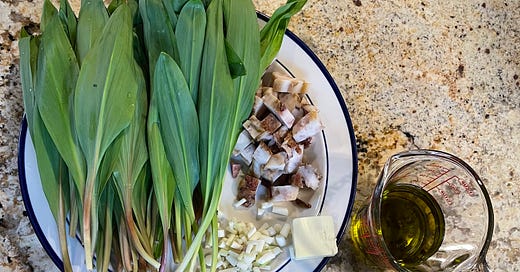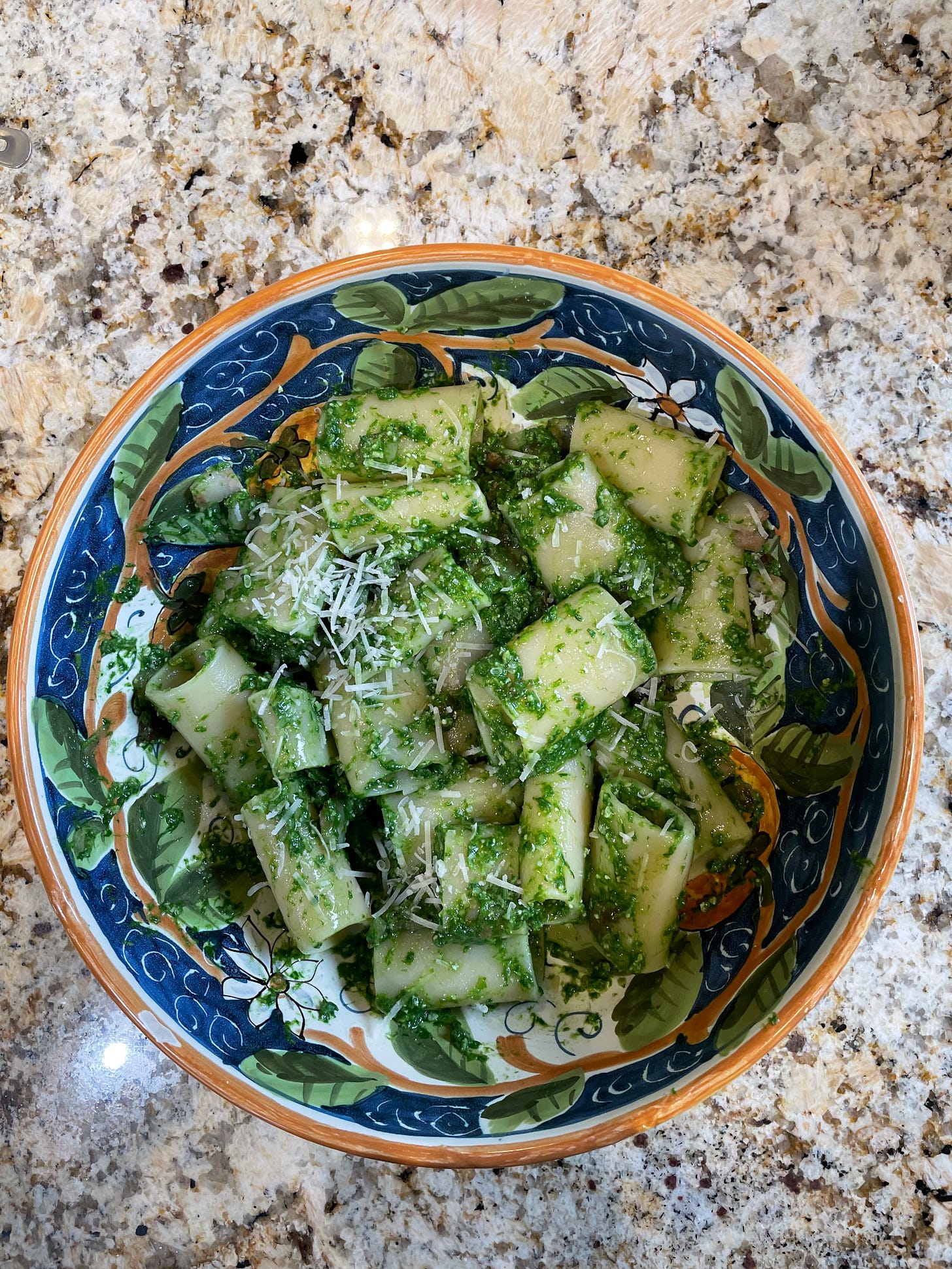I love April in Ithaca. Sure, the landscape still reads mostly wintry brown and any fine blue-sky days can be followed by a string of dreary, bone-chilling sleety ones. But overall color is returning, flowers are in bloom, the sun is beginning to warm and the increasing temperatures – even if near freezing overnight – bring hope for the new growing season.
April also means the Ithaca Farmers Market emerges from its indoor winter shelter along the corridors of Triphammer Mall to reoccupy its Steamboat Landing location on the Lake Cayuga shoreline. No matter what the April weather had in store, vendors and customers alike seemed overjoyed to be back for the start of the market’s 51st season.
On a recent Saturday, I walked up to a stall with a burning question, “So, is Persephone over?” Lucy Garrison-Clauson, who, with her husband, Chaw Chang, owns Stick and Stone Farm, beamed. “Oh, yes”, she said gently correcting my usage, “the Persephone period is definitely over.”
Throughout this past winter I’d grown increasingly amazed by, and more curious about, the bounty and variety of greens on display week after week at the indoor farmer’s market. How, in the depths of winter, is it possible to have an abundance of beautiful, lush, delicious, nutritious greens? I decided to find out.
One snowy mid-March morning, I drove up the west side of the lake to Stick and Stone Farm, where Lucy led me first to see where the farm’s winter vegetables are stored. By the time of my visit, the farms large storage areas were mostly empty. She explained that at the end of last fall’s harvest, the rooms had been filled pretty much floor to ceiling. Lucy predicted that what remained of last fall’s vegetable harvest – hearty roots (carrots, potatoes, rutabagas, turnips, Korean radishes) and bulbs (onions, garlic, and shallots) – would be completely sold out in a few weeks. A gigantic vegetable tumbler rotated nearby releasing washed shiny carrots onto a table to be sorted into two-to-three-pound bags destined to be snatched up at the next Saturday market.
Then we went outside, trudged through some snow, and entered the first of four high tunnels – plastic covering over metal frames. There, plentiful and lush, were the greens I had come to see: an enticing array of raabs. According to the Land Connection, raab (or rabe) refers to “the springtime buds, leaves, and flowers of over-wintered brassicas, especially those in the turnip family”. Stick and Stone offers several, including: kale raab, mustard raab, napa raab, mizuna raab.
When I asked if these high tunnel plants were actually growing, Lucy said, “Technically, no. We’re still in what’s called the Persephone period, or Persephone days” when both cold temperatures and, importantly, short day length conspire to slow and, for some crops, completely halt plant growth. Even with no artificial heat, the temperature inside cold frames or green houses (like the high tunnels) can stay above freezing and protect plants from wind damage, even during long Northeastern U.S. winters.
Without artificial light, which is not used at Stick and Stone or area other farms, there’s not much to be done about day length. Most plants require at least 10 hours of daylight for active growth. These nutrition-packed green vegetables keep very fresh with this rooted-in-the-soil refrigeration awaiting harvest for each market day.
Master Winter gardener Eliot Coleman and author of The New Organic Grower, Four-Season Harvest, and The Winter Harvest Handbook, is credited with using the term, Persephone days, named after the Greek agricultural Goddess of Spring, who also presided over the dead in the Underworld with Hades.
The visit to Stick and Stone Farm was certainly eye-opening and solved the mystery of how several local farms are such abundant and dependable suppliers of deep green vegetables throughout the winter. Not only do all these raabs taste great, they’re also nutrient-rich. Varieties differ in nutrient content, but several types of raab are excellent sources of vitamins A, C, and K, as well as minerals such as potassium, calcium, and iron. They’re also good sources of complex-B vitamins, manganese, and phosphorous.
Elijah Liebson, of Six Circles Farm, also sells a variety of raabs, which, like other cruciferous vegetables, have a reputation for bitterness. I mentioned that it seemed to me that by this time of year that typical bitterness was mellowing and raabs seemed to be getting sweeter. What’s going on? Elijah explained that in the winter “raabs actually get sweeter because they concentrate more sugar in their cells”. While this is quite pleasing to my palate, it’s a matter of survival for the plant. Since sugar lowers freezing point of the vulnerable plant cells. In this way, vegetables gradually increase their tolerance of temperatures well below zero. Very cool.
After loading up on raab for the week – it’s become a winter and early spring staple for me and my husband – we walked on through the farmers market pavilion where one of the first true harbingers of spring caught my eye – ramps!, also know as wild leek, spring onion, or ramson.
Karma Glos of Kingbird Farm harvests the first of this truly wild crop from the wooded area of her land. “Ramp season is really short”, she explains, and she expects to sell them “only a few more weeks”. I bought a bunch the first day she had them and then more on the next. The long ovate ramp leaves were at least a full inch longer one week later.
A small sign next to the ramps claimed the ramps are Certified Organic. I was curious about that since the crop is wild. Karma explains the certification, from the Northeast Organic Growers Association of NY (NOFA-NY), relates to her careful management of the forest where the ramps grow. Though she does harvest some entire plants (leaves, stalks, bulbs and all), she cuts about half of the harvest at the base of the ramp, leaving the roots and the ground around it undisturbed. When she harvests the entire plant, she uses a pitchfork to minimize damage and disturbance to nearby trillium and bloodroot. This minimal impact encourages the ramps to thrive and grow year after year.
Karma considers ramps “a rare, special treat that available for only a few weeks”. She harvests enough for only about 100 bunches each week. I consider being able to buy a few bunches of sustainably harvested ramps each week during its fleeting season a rare treat, too. My current preferred way to enjoy ramps is to make a pesto and have over pasta with some Parmesan cheese. Delightful.
Ramp Pesto with Paccheri Pasta
Rinse 2 bunches (~ 5 oz) of ramps and trim the white stems and bulbs from the greens.
Set a small pot of water on high heat.
In a small skillet, cook 3 oz jowl, or guanciale*, in ~1Tbs olive oil over medium-low heat. When cooked, transfer to a small bowl, leaving the flavorful fat in the pan.
Use reserved fat to sauté the ramp bulbs and white stem parts, stirring now and then until tender.
While this is going on, blanch the leaves in salted boiling water for about 20 seconds. Using tongs, transfer to bowl of ice water. When cool, drain the leaves, squeeze out the excess liquid, and coarsely chop. Reserve the hot blanch water.
Purée the ramp greens, sautéd stem ends and bulbs, with ¼ C olive oil, and a scant ¼ C of pinenuts (or walnuts or pistachios, your choice). Add ¼ C Parmesan cheese, and process until smooth. Add a little more olive oil if the mixture seems too thick. Season with salt and pepper.
Bring reserved water back to a boil. Salt the water and add 6 oz of your choice of pasta. I used Paccheri because it was in the cupboard (and had been unopened for about 3 years) but think fusilli, or rigatoni, or strozzapreti would be just grand, as well. Cook pasta, stirring occasionally, until dente. Reserve a little of the pasta water.
Empty pasta from food processor into a bowl. Add the hot pasta, guanciale and tow vigorously. If the pesto turns out to be too thick add a bit of pasta water and perhaps 1 t. butter. (I found neither was necessary, but perhaps I didn’t squeeze out enough water in step 5). Divide the pasta into two bowls, sprinkle with more Parm. Enjoy!
*Ours is from Wixom Farm in Mecklenburg, which you’ll hear about in a future post.
A week after opening its 51st season, the Ithaca Farmers Market received a visit from state Senator Lea Webb (D, WF, 52nd District, NY). The purpose of the visit was to announce and deliver a large grant from the state for much needed renovations and improvements to the farmers market so that it can continue to providing benefits to the community. Webb really gets the importance of farmers markets for community development, for starting and supporting small businesses, and much more.
“One of the many things that are important to me is supporting great organizations, great community partners that are doing what I call ‘the good work,’” Webb said. “The Ithaca Farmers Market provides incredible support, as it’s been noted with economic development, addressing complex issues around food insecurity, and so much more.”
“It’s an honor to be here to give support, not just through policy, but with financial support,” she said as she delivered the check, representing the first such capital investment her senate office is making. “So Ithaca Farmers Market is the first recipient of this particular funding that I get.”
With so many flowers and trees in bloom, an abundance wild greens and over wintered hearty raabs, and generous public investments in market improvements, things are truly ramping up. Now, I’m off to cook. I can think of no better way to mark this Earth Day than by cooking foods produced by local farmers who care for the land, safely store what remains of last fall’s harvest, and nurture seedlings for the new season.






There is so much good stuff in this post! I appreciated learning about raabs, sustainable wild harvesting, opportunities for state investment in farmers markets and a recipe to boot. Thank you!
I thoroughly enjoyed this, and am excited to try the ramps pesto recipe! Great work